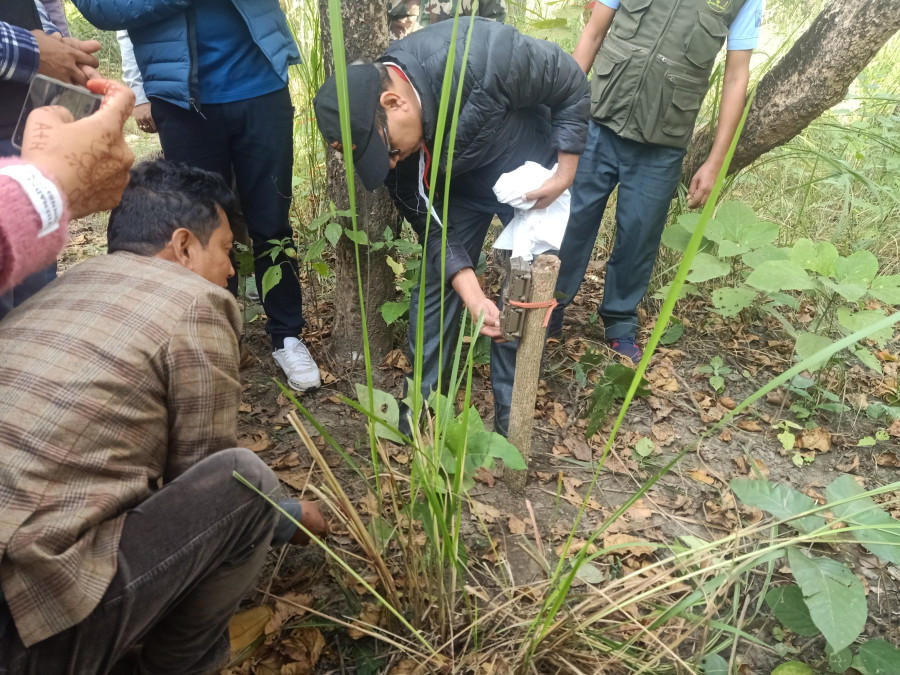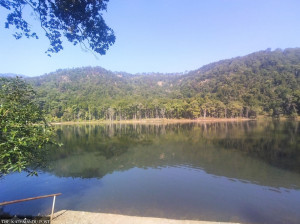Sudurpaschim Province
Annual tiger counting starts in Shuklaphanta
A national census of tigers is conducted in Nepal every four years, but the Shukhlaphanta National Park counts its tigers annually.
Bhawani Bhatta
The Shuklaphanta National Park started the monitoring and counting of tigers in the park from Friday. The tigers will be tracked and counted using the camera trapping method for 15 days.
A national census of tigers is conducted in Nepal every four years. The national census of tigers conducted in 2018 put the number of adult big cats in Shuklaphanta at 16. According to the national census conducted in 2022, the number of adult tigers at Shuklaphanta National Park (SNP) has reached 36.
Along with the national census, since 2021, SNP has also been conducting an annual census in the park every year. The counting is done in coordination with other agencies as a part of routine monitoring of tigers in protected areas as well as in low-density areas to prevent the risk of poaching and human-animal conflict.
According to the census carried out between May 18, 2021, and June 6, 2021, by the park, 19 adult tigers, including six males, 11 females, and one whose gender is yet to be determined, were recorded in the park.
According to the park, during the national census, along with the protected areas, other areas with tiger habitats were also monitored. However, the core area of focus for the current monitoring session is the main habitat of tigers inside the park area.
Similarly, the process of installing cameras and monitoring also started on Friday.
Lakshmiraj Joshi, head of the National Trust for Nature Conservation’s SNP conservation programme, said that the park has an area of 350 square kilometres and is divided into 92 grids of 2 by 2 square kilometres. One pair of automatic cameras with motion sensors will be installed in every grid in the tigers’ walking path. The installed cameras will be regularly monitored and maintained for 15 days. After 15 days, the cameras will be removed, and the pictures will be analysed.
According to Dr Sindhu Prasad Dhungana, director general of the Department of National Parks and Wildlife Conservation who has been involved in monitoring wildlife including tigers, the method of collecting pictures of tigers with automatic cameras is considered to be the most effective and safest method for tiger counting.
“SNP has proved itself successful in wildlife conservation. The number of tigers, rhinos, blackbucks, and swamp deer (Rucervus duvaucelii), locally called Barhasingha, is constantly increasing in the park. Annual monitoring conducted by the park will help to understand patterns of tigers and conduct further research. It also helps in training new researchers and conservationists,” said Dhungana. “Along with the park officials, technicians from the National Trust for Nature Conservation, the Zoological Society of London, Himalaya Nature, and others are participating in the monitoring process.”
According to Joshi, the cameras were installed after collecting the necessary data, such as where tigers stroll and live, identifying footsteps, the coordinates of visuals of tigers, and other signs. The movement of tigers was recorded frequently in some specific locations this monsoon season, making it easier for the team to monitor and count tigers.
“The cameras are installed at a height of 70/80 cm from the ground. Technicians will use safe vehicles and elephants in the park for daily monitoring for 15 days,” said Joshi.
In the census conducted in 2022, one tiger was spotted in the Laljhadi Mohona Corridor and another in the Jogbudha area. The tiger seen in Laljhadi Mohona was also spotted in the core areas of the park, but there were no other sightings of the tiger seen in the Jogbudha area. The park officials suspect that the other tiger may have come from Nandhaur Wildlife Sanctuary in India.
According to the park, the park area is suitable for tigers because of the availability of prey and habitat. According to the 2022 census, over 146.6 wild animals (prey) were found per square kilometre inside the park.
“Even though Shuklaphanta is a good habitat for wild animals, including tigers, due to human settlements in the core area of the park (Dakka Camp), along with physical structures being built in the park, including road construction and irrigation canals, there is a problem with the migration of animals,” said Joshi. “People who were displaced during the expansion of the then Shuklaphanta Wildlife Sanctuary could not be resettled; they are still living in Dakka camp,” said Joshi.
According to the national census of 2022, the migration of tigers has not happened in the eastern region of the park since the census of 2018.




 16.12°C Kathmandu
16.12°C Kathmandu












